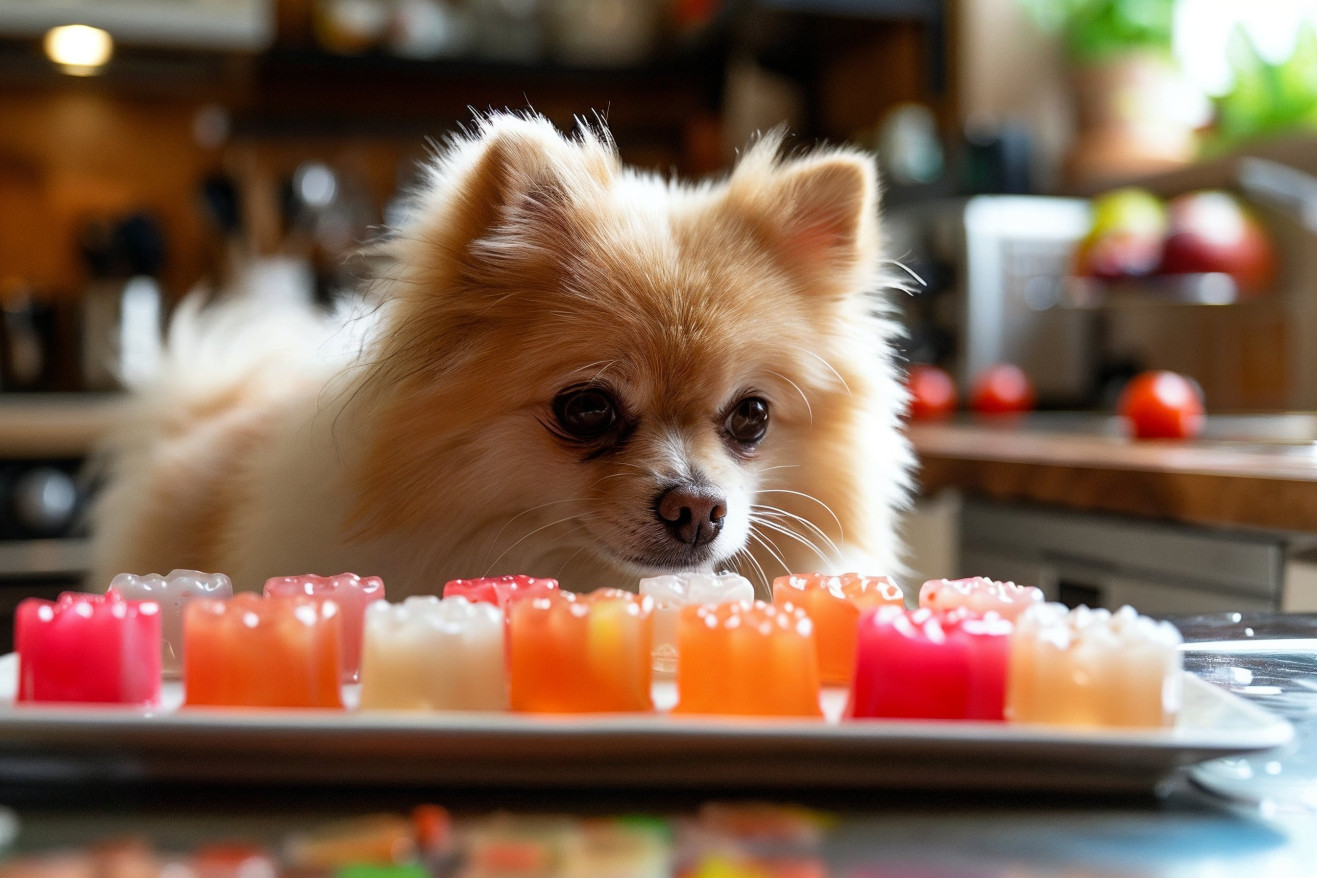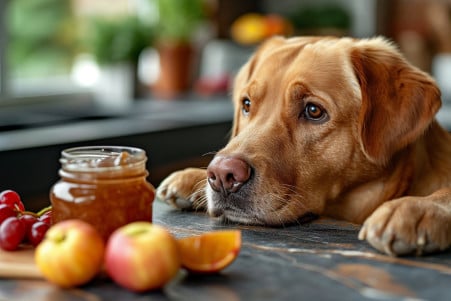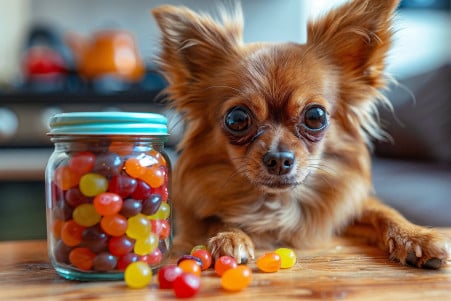Can Dogs Eat Jello? What to Know About Healthy Dog Treats
21 February 2024 • Updated 20 February 2024

Jello is a classic dessert, but is it something that you can share with your dog? While plain, unflavored gelatin can be given to dogs in small amounts, most store-bought Jellos are made with artificial sweeteners like xylitol, which is poisonous to dogs, or high amounts of sugar, which can be detrimental to their health. Homemade gelatin treats are a better option.
This article will explore the nutritional needs of dogs, the effects of artificial sweeteners and sugar on dogs, and the dietary considerations that dog owners should keep in mind. It will also discuss information from veterinary nutrition professionals and research on dog metabolism to help explain why certain treats, including Jello, can be bad for dogs.
You will also find out how to make sure that your dog’s diet is not just fun but also healthy and supportive.
Can dogs eat jello?
How to Balance Diet and Treats for Your Dog’s Nutrition
A balanced diet is one that furnishes your dog with the nutrients they need for energy, growth, and cell repair, and it’s essential for their well-being. According to the ASPCA, a high-quality commercial dog food should be nutritionally complete and balanced, meaning it contains all of the nutrients, including proteins, fats, carbohydrates, vitamins, minerals, and water, that are necessary for a dog’s overall health.
While treats can be a fun part of your dog’s diet, they should be fed in moderation. The ASPCA recommends that no more than five percent of your dog’s daily caloric intake come from treats to prevent obesity and nutritional deficiencies. Commercial Jello, while a tasty option for people, is generally not nutritious for dogs and may contain artificial sweeteners or sugar.
When choosing treats for your dog, it’s important to make sure they’re both safe and nutritious. According to the American Kennel Club, unflavored gelatin can be a good treat for dogs and may have health benefits, including promoting joint health and aiding digestion when used in moderation. Make sure that the treats you feed your dog don’t upset the nutritional balance of their regular diet.
To ensure that your dog’s diet is nutritionally balanced, make sure to give them treats in moderation, prioritize their nutritional needs, and choose treats carefully. Always remember that when it comes to treats, quality is more important than quantity, especially when it comes to maintaining your dog’s health.
Artificial Sweeteners: A Risk to Dogs
Despite their popularity in the human diet, artificial sweeteners are dangerous for dogs. Xylitol, in particular, is a sugar substitute that can be toxic to canines. According to the FDA, xylitol can cause a rapid and severe drop in blood sugar (hypoglycemia), seizures, liver failure, and death in dogs. The toxic effects can happen within 10 to 60 minutes of consumption, so immediate veterinary attention is needed.
According to Poison Control, signs of xylitol poisoning in dogs include vomiting, weakness, lack of coordination, and seizures. Xylitol is used in many sugar-free products, including gum, candy, and baked goods, so accidental ingestion is a real risk. The American Kennel Club says it’s important for pet owners to carefully read labels and keep all products that contain xylitol out of their pets’ reach.
To keep your pets safe, always give them treats that are made for dogs and don’t share your treats with them. By paying close attention to your dog’s diet and understanding the risks associated with certain human foods, you can help your pet avoid the serious health problems that can come with artificial sweeteners like xylitol.
The Bitter Truth: How Sugar Affects Your Dog’s Health
While your dog may enjoy the occasional sweet treat, the consequences of a high-sugar diet can be detrimental to their well-being. Obesity and dental problems are just the beginning. When dogs eat more sugar than their bodies can use, the excess can lead to obesity and open the door to a host of other health issues.
Dental problems are also likely, as sugar feeds the bacteria in a dog’s mouth, leading to tooth decay and other issues.
Sugar also has a big impact on a dog’s metabolism and can lead to diabetes. This is a real concern, as PR Newswire reports that there has been a 32% increase in the number of dogs diagnosed with diabetes since 2011. Dogs’ bodies process sugar differently than humans’, which makes the potential for negative health effects even greater. Their bodies aren’t built to handle high amounts of simple carbohydrates that cause blood sugar to spike.
You can protect your dog by limiting their sugar intake and choosing healthier treats like blueberries or carrots. Not only do these options provide a health benefit, but they don’t have the negative effects of processed sugars. By choosing the right treats, you can make sure your dog’s diet is well-rounded and sets them up for a healthy, happy life.
Making Healthy Homemade Gelatin Dog Treats
Making homemade gelatin dog treats is a great way to give your pet a healthy and safe snack. Unlike Jello, which is often packed with unhealthy additives, homemade treats made with natural ingredients like unflavored gelatin can be good for your dog. According to NutriFlex, gelatin is packed with proteins and amino acids like glycine, which can help with cognitive function and support the gut.
To make a simple gelatin dog treat, mix one tablespoon of unflavored gelatin, like Now Foods gelatin powder, with one cup of warm, pet-safe bone broth. Pour the mixture into molds and refrigerate for 5–6 hours, or until the gelatin has set. Based on the gelatin in Canine Works, this recipe uses gelatin’s anti-inflammatory properties to help with bone, joint, and skin health.
That said, it’s important to use gelatin in moderation. Most recommendations suggest that no more than five percent of your dog’s daily caloric intake should come from treats.
In addition, make sure you’re using gelatin in a way that’s safe for your dog. Introduce it in small amounts to make sure your dog can tolerate it and that it doesn’t throw off their diet. If you follow these tips from the experts, your dog can get the health benefits of gelatin without the negative effects of unhealthy treats.
Canine Dietary Restrictions
When it comes to feeding our dogs, it’s also important to remember that some things that are safe for humans to eat can be toxic to dogs because of differences in metabolism. For example, grapes, onions, and chocolate all contain substances that dogs can’t metabolize well, which can lead to toxicity and potentially serious health problems.
The American Kennel Club also lists garlic, macadamia nuts, and anything containing the artificial sweetener xylitol as other human foods that dogs should never eat. Xylitol is especially toxic and can cause hypoglycemia and liver failure.
That said, there are also many human foods that are safe for dogs and can even be healthy for them. For example, plain, cooked meats like chicken and turkey and certain fruits and vegetables like blueberries and carrots can make great treats in moderation and provide nutrients and fiber. Healthline also notes that dogs can eat peanut butter for a protein boost, but it needs to be unsalted and free of xylitol.
Pet parents can help ensure their dogs’ well-being by carefully monitoring what they eat. Always check labels for potentially toxic substances, introduce new foods slowly, and stick to a diet that’s mostly high-quality dog food, with treats making up no more than 5% of their daily caloric intake, according to the ASPCA.
By understanding and abiding by these dietary restrictions, you can make sure your dog has the best chance of living a long and healthy life.
Recap: How to Make Sure Your Dog’s Diet Is Safe and Healthy
As we’ve discussed in this article, while Jello is a popular dessert for people, it may not be the best choice for dogs. According to the FDA, commercially prepared Jello is not safe for dogs because it contains high levels of sugar and artificial sweeteners like xylitol, which is extremely toxic. However, homemade gelatin treats that don’t contain any harmful additives can be a safe and even nutritious treat if they’re fed in moderation.
The most important thing to remember is to stick to the dietary limits for treats, which means that treats should only make up a small portion of your dog’s daily intake. This will help ensure that your dog’s diet is nutritionally balanced and that they won’t experience any of the health problems that can come from consuming too much sugar or artificial sweeteners.
In short, being a good pet parent means being a smart treat consumer. By learning what’s safe and what’s not, pet parents can make sure that their dogs’ diets are not only satisfying but also supportive of their long-term health and well-being. Keep your dog’s dietary needs in mind, enjoy making your own homemade treats, and help your furry friend live a long, healthy life.


